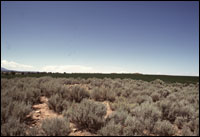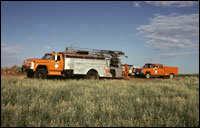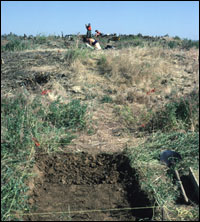The Archaeology of 5MT2
By Richard H. Wilshusen
Site 5MT2 is one of three sites in the Joe Ben Wheat Site Complex (5MT16722), which was listed to the National Register of Historic Places in 2004 (Lekson 2004Lekson, Stephen H.
2004 National Register of Historic Places Registration Form for Joe Ben Wheat Site Complex (5MT16722). Site listed on the National Register on January 16, 2004. Form on file at Colorado Historical Society, Denver.). It was the last site to be investigated, and although the site excavations were not directed by Joe Ben Wheat, he influenced the focus of the investigations and trained the graduate student, John Cater, who was largely in charge at 5MT2. The primary public document on the excavations is John Cater's MA thesis (1989Cater, John D.
1989 Chronological Understanding of Site 5MT2, Yellow Jacket, Colorado, and a Study of Abandonment Modes. Unpublished MA thesis, Department of Anthropology, University of Colorado, Boulder.). The three seasons of work at this site have broadened our understanding of Wheat's original work in the Porter area of site 5MT1 and considerably enhanced our understanding of the occupation history of the smaller sites in the Yellow Jacket community.
Site 5MT2 consists of two roomblock-kiva complexes, which are approximately 25 m apart from one another (Plan Map of 5MT2 - pdf format). The northern portion of the site has a large roomblock and kiva and was called House 1 in the excavations. It dates to the late Pueblo III period, or approximately A.D. 1200-1280. The southern roomblock and kiva were called House 2 in the excavations and date to the early Pueblo III period, or sometime between A.D. 1160 and 1225. Additional information about the occupational history of the site are detailed in the chronology section. In this report we refer to the two roomblock-kiva complexes by either their position (i.e., north and south), their primary periods of occupation (i.e., late Pueblo III and early Pueblo III), or by area (i.e., Areas 1 and 2) rather than by the house numbers (House 1 and 2) that defined them in the field.
The early Pueblo III component centered on the southern roomblock and kiva had been heavily salvaged in prehistoric times, so the structures were largely disassembled. Cater and his crew investigated the kiva and portions of four of an estimated six rooms in the roomblock. There was relatively little primary refuse left in situ, so much of what is understood about the prehistoric use of this area is based on inferences drawn from what remains of the disassembled buildings. There were only very limited excavations outside of the structures and the structures had remarkably few associated features. A detailed presentation of the excavation results can be found in this report's section on the architecture of the site.
Cater's excavations in the northern roomblock-kiva complex revealed a late Pueblo III component with a single kiva, a 14-room masonry pueblo, and an associated diffuse midden and a burial. Although the architecture exposed in this work is typical for the Mesa Verde region, these investigations complemented what was learned regarding the Pueblo III occupations in the Porter area of 5MT1 and allowed a much fuller conception of how the occupations of 5MT1, 2 and another nearby, but as yet unnumbered site, were almost certainly interrelated. The architectural features of the later component at 5MT2 are described in the discussion of the late Pueblo III component at the site.
 |
View of 5MT2 from 5MT3. Site 5MT2 is visible as the sage-covered mound in the center. (SL-YJ-183) |
There is little doubt that the social and economic affairs of this small community were influenced throughout Pueblo III by Yellow Jacket Pueblo (5MT5), the largest site in the Mesa Verde region, and located just 500 meters northeast of the three sites of the Joe Ben Wheat Site Complex. The social and natural setting of 5MT2 are discussed in another section of this report.
History of Research
Site 5MT2 was excavated in 1986, 1987 and 1988, under the general direction of Dr. Fred Lange of the University of Colorado Museum, and the field direction of John Cater under the supervision of another graduate student, Mark Chenault, in the first year. The site was reported in Cater's (1989Cater, John D.
1989 Chronological Understanding of Site 5MT2, Yellow Jacket, Colorado, and a Study of Abandonment Modes. Unpublished MA thesis, Department of Anthropology, University of Colorado, Boulder.) MA thesis at the University of Colorado. Dr. Joe Ben Wheat was not directly involved with the field research, but his presence and advice is extensively acknowledged in Cater's MA.
 |
CDOT trucks preparing for GPR survey of 5MT2 (SL-YJ-JC-002) |
Provenience designations mixed a grid system with the conventional Yellow Jacket system of "test units" or "excavation units." The grid system was not extensively used after the first season. Trench and midden units (as excavated) were typically provenienced and excavated in 1 by 2 m units. "Test" or "excavation units" either conformed to architectural units or approximated a 2 by 2 m, or a 1 by 2 m size.
 |
Initial excavations for 16 m test trench in Area 2, facing north. (SL-YJ-JMT-005) |
There was also a soil-testing program such that soil stratigraphy was documented close to Site 5MT2 and in an area within approximately one mile of the site. It appears that a total of four to five locales were documented by small excavations, samples, and stratigraphic descriptions. Although some notes associated with this program are in the Yellow Jacket archives, no final report has been found. The notes have been a useful resource in the description of local soils and sediments in the natural setting section of this site report.
The architectural units exposed by the trench were excavated primarily during the 1987 and 1988 field season in "test units" or "excavation units;" these units were excavated in natural layers or 20 cm horizontal levels and were mostly unscreened. Rooms were typically excavated as a single unit, and kivas as multiple excavation units, generally in the quarters defined by the north-south and east-west trenches that originally bisected them. Several 1 by 1 m units in the fill of selected rooms were screened and both kivas had 1 by 1 m units that were systematically screened through one-quarter inch hardware mesh; other structural fill generally was not screened, with the exception of some vertical units within 5 cm of floor level. Room excavations expanded outward from units initially transected by the original north-south trenches. Fourteen well-defined surface rooms were ultimately excavated in the northern roomblock. In the southern roomblocks the rooms had been heavily damaged by prehistoric salvage of the structures, but it is estimated that portions of four rooms were excavated.
About one half of the upper fill of both of the kivas was removed with a backhoe; the remainder of the structural fill was removed in trenches and quarters which were hand-excavated with shovels and trowels. Floor artifacts in rooms and pit structures were point-located and mapped in the field notes. Plaza areas between the late Pueblo III kiva (Kiva 1) and the associated northern roomblock were stripped in three separate test units. Plaza excavations in the southern roomblock were limited to a single 4 by 4 m area west of the kiva. A diffuse, disturbed midden area was noted in the plowed fields for 20 m to the east of the northern roomblock and extending to the southern roomblock. Two 1 by 8 m test units, with a smaller extension to the northern unit, were excavated in this midden, exposing a single burial pit. All sediment from midden excavations was screened through quarter inch hardware mesh.
This Report and Cater's Original Interpretations
Although we have constantly cited and relied upon John Cater's (1989Cater, John D.
1989 Chronological Understanding of Site 5MT2, Yellow Jacket, Colorado, and a Study of Abandonment Modes. Unpublished MA thesis, Department of Anthropology, University of Colorado, Boulder.) Master's thesis in this report, we must emphasize that some aspects of this web report of 5MT2 do not match the archaeological interpretations offered by Cater. We would urge any researcher looking at the architectural details and at the sequence of occupation to also consult Cater's MA. We will note two matters that do affect our site interpretations and of which the reader should be aware.
Cater proposed an early post and adobe (or jacal) roomblock (e.g., Cater 1989:Figure 18Cater, John D.
1989 Chronological Understanding of Site 5MT2, Yellow Jacket, Colorado, and a Study of Abandonment Modes. Unpublished MA thesis, Department of Anthropology, University of Colorado, Boulder.) built in conjunction with a hypothesized early construction of Kiva 1 in the northern portion of the site. He dated this proposed earlier construction to as early as A.D. 1075 and argued this post and adobe roomblock was torn down and remodeled into the beginnings of the masonry pueblo by the mid-twelfth century. He based his argument primarily on the presence of an early post and adobe building component documented by Joe Ben Wheat at 5MT3—as well as some the tree-ring dates at 5MT2—and suggested that the occupation at 5MT2 followed a similar sequence as at 5MT3. We chose a more conservative interpretation based on the available architectural and chronological evidence and proposed instead that the first component of construction at 5MT2 occurred, at the earliest, at about A.D. 1160 with the construction of the southern roomblock. There was not enough evidence in the excavated record for us to be certain of the earlier component proposed by Cater, so it is not included in our report.
A second issue has to do with the connections between the sites in the Joe Ben Wheat site complex (Lekson 2004Lekson, Stephen H.
2004 National Register of Historic Places Registration Form for Joe Ben Wheat Site Complex (5MT16722). Site listed on the National Register on January 16, 2004. Form on file at Colorado Historical Society, Denver.). Whereas Cater emphasizes the potential similarities in the occupation sequences of sites 5MT2 and 3, we have focused primarily on the ties between 5MT2 and the Porter area of 5MT1, as well as an unnumbered roomblock 40 m to the southeast of 5MT2. The site history of 5MT2 and its potential links to the two roomblocks just to the southwest (Porter) and southeast (the unnumbered roomblock) figure much more prominently in our discussion than the connection to 5MT3, which is over 200 m to the northwest. Certainly the much larger site of 5MT3 and the slightly more distant, but immense, Yellow Jacket Pueblo (5MT5) must have exerted a powerful influence on the development of 5MT2, but we construe the cluster of the three smaller sites (i.e., 5MT1 and 2, and the unnumbered roomblock) to be more important in our interpretation of site-specific chronological and architectural questions for 5MT2.
Cater directed the primary excavation work at 5MT2 and made many of the fundamental interpretations that we reference in this site report. So, while we are confident that our site report is quite reasonable, any researcher making comprehensive use of 5MT2 materials should consult Cater's MA (1989Cater, John D.
1989 Chronological Understanding of Site 5MT2, Yellow Jacket, Colorado, and a Study of Abandonment Modes. Unpublished MA thesis, Department of Anthropology, University of Colorado, Boulder.) as well as pertinent excavation notes.

 Introduction
Introduction